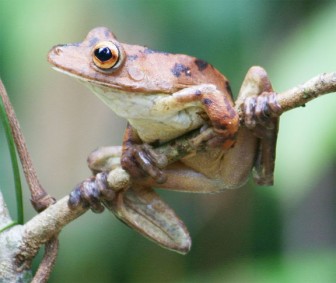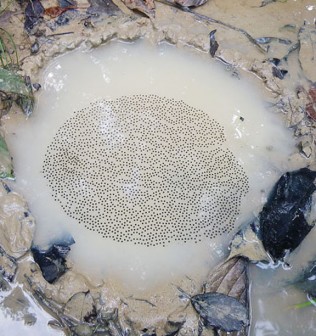The Giant Gladiator Frog (Hypsiboas boans) belongs to the family of tree frogs (Hylidae). This species is widely distributed in northern South America and is even found on the island of Trinidad; it prefers a forest habitat along streams and rivers but can also be found in more open areas.
The Giant Gladiator Frog can grow up to 13 centimetres and has a variable coloration from light to dark brown, sometimes with darker markings. Its eyes are big with a bronzy coloured iris and the lower eye lid has silvery gold reticulations.
The frog’s toes and fingers are well adapted to its arboreal lifestyle, and are tipped with big discs that give it a good grip, suited to life in the trees.

This nocturnal species has a special mating behaviour; during the reproductive season males excavate shallow basins in sand or other suitable substrates at the edge of creeks, rivers or ponds. The males show territorial behaviour and will fight to defend these nesting sites against other males, which is why Hypsiboas boans is called ‘The Gladiator Frog.‘ If necessary they can even use exposed spines on their thumbs to fight their rivals.

Once a female is attracted by the male’s loud and hollow booming call, she deposits up to 3,000 eggs in the mud basins. The nest construction protects eggs and early tadpole stages against the high variety of aquatic predators found in the streams and ponds. During heavy rains tadpoles are washed into adjacent water bodies for further development.
If caught this frog makes a loud cat-like ‘meow,’ which normally surprises its captor giving it enough time to make its escape from the jaws of hungry predators or curious humans.





